92 - Pulmonary Paragonimiasis and Its Surgical Complications
Editors: Shields, Thomas W.; LoCicero, Joseph; Ponn, Ronald B.; Rusch, Valerie W.
Title: General Thoracic Surgery, 6th Edition
Copyright 2005 Lippincott Williams & Wilkins
> Table of Contents > Volume II > Section XVI - Carcinoma of the Lung > Chapter 107 - Mediastinal Lymph Node Dissection
Chapter 107
Mediastinal Lymph Node Dissection
Tsugo Naruke
Mediastinal lymph node dissection (systematic lymph node dissection) in lung resection is essential for achieving accurate staging. However, the basic controversy surrounding the therapeutic value of systematic lymph node dissection for lung cancer is similar to that related to the need and efficiency of lymph node dissection in tumors of other organ systems. Resection of the primary lesion and the regional lymph nodes en bloc is the surgical treatment of lung cancer that is universally accepted in Japan and many other countries.
There are four major arguments against systematic lymph node dissection:
The systemic nature of the cancer. Cancer may have spread outside of the thoracic cavity.
Complete dissection is difficult. One hundred percent removal of all lymph nodes may not be possible.
The effect on the immune system. Removal of normal lymph nodes may reduce normal immunologic resistance.
Surgical risk. Increased surgical risk has not been justified by improved patient prognosis. Izbicki and associates (1994) attempted to examine prognosis by a randomized clinical study among a limited number of cases, one group with lymph node sampling and the other with systematic mediastinal lymphadenectomy, and the outcome indicated no prognostic benefit to surgery.
There are four basic arguments supporting complete dissection:
Microscopic identification is the only method to verify the true stage of the lung cancer.
Reliable staging information will produce a more effective postoperative treatment plan.
Systematic lymph node dissection does not increase operative risk, operative mortality, or postoperative quality of life.
Many surgeons report increased survival rates when mediastinal lymph node dissection is done. Among these surgeons are Smith (1978), Rubinstein and collaborators (1979), and Kirschner (1981), as well as Martini (1983) and Watanabe (1991) and their associates. The author (1967) and my colleagues (1976, 1978, 1999), as well as Kirsh and Sloan (1982) subscribe to the same opinion. Other surgical reports are noted in the Suggested Reading. A recent report by Keller and associates (2000) presented data that supported the effectiveness of mediastinal lymph node dissection by way of a comparative study of prognosis through a randomized clinical study of mediastinal lymph node dissection and lymph node sampling.
The standard surgical procedure for patients with lung cancer is either lobectomy or pneumonectomy combined with a complete mediastinal lymph node dissection. Cases in which the lobe or lung containing the primary lesion has been resected and a systematic dissection of mediastinal lymph nodes as well as the hilar lymph nodes has been done are termed radical (complete) operations. Cases in which mediastinal lymph node resection has been performed incompletely are termed palliative or noncurative operations. Limited surgical lymph node dissection is accepted only for compromised patients or in patients with small peripheral early-stage cancer with limited pathology.
With a complete mediastinal lymph node dissection, not only ipsilateral mediastinal lymph nodes but also the contralateral lymph nodes are dissected on the right side by a standard right posterolateral thoracotomy. A bilateral lymph node dissection cannot be performed on the left side by standard left thoracotomy; it is necessary, depending on the site and presence of ipsilateral mediastinal lymph node metastases, to perform a contralateral lymph node dissection by mobilization of the aortic arch or with an additional median sternotomy in potentially curable patients with locally advanced lung cancer.
This chapter presents an original nomenclature of lymph nodes and operative procedures to ensure a complete systematic lymph node dissection.
P.1589
SITES AND NOMENCLATURE OF LYMPH NODES
Although many reports have been presented in the past on the topography of the mediastinal lymph nodes and on the usual routes of lymphatic spread, no standard terminology was available for the location of mediastinal and bronchopulmonary lymph nodes in order to record the sites of nodal metastases clinically. The author (1967) and associates (1976, 1978) produced a lymph node map based on a large number of lymph node dissections combined with lung resection for lung cancer in relation to the bronchial tree, thoracotomy findings, and resected specimens (Fig. 107-1A, B; see Color Fig. 107-1A, B). This original map used the many basic studies of Rouviere (1932), Borrie (1952), Nohl (1956, 1962), and Cahan (1960), among others, and suggested a nomenclature for the mapping of the intrathoracic lymph nodes. This system of lymph node mapping was subsequently recommended by the American Joint Committee in 1976, and its
P.1590
P.1591
use has been supported by the reports of Mountain (1976) and Martini (1976). These reports of the classification of lung cancer were in agreement with the suggested TNM classification of malignant tumors by Union Internationale Contre le Cancer (UICC) for the graphic representation of the operative findings.
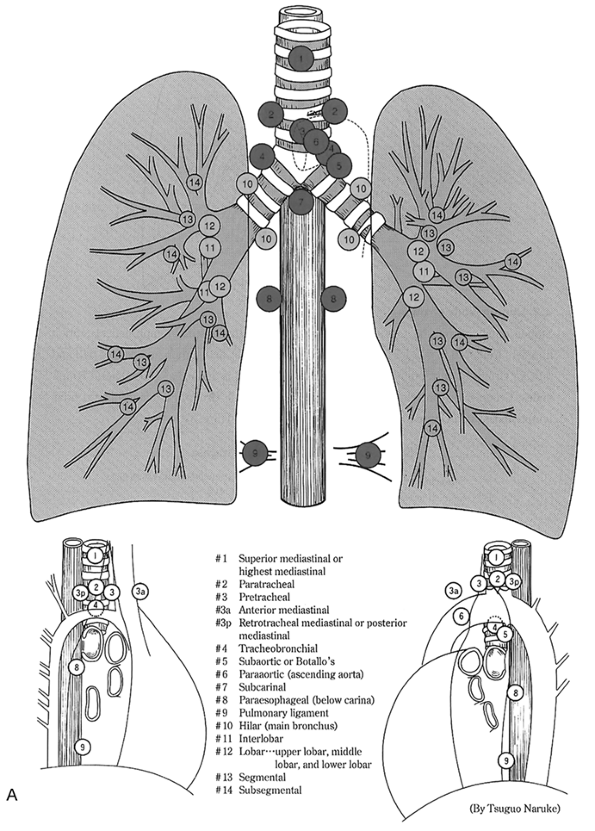 |
Fig. 107-1. A. Lymph node map recommended by the American Joint Committee on Cancer, Union Internationale Contre le Cancer, and the Japan Lung Cancer Society. (See Color Fig. 107-1A.) From Keller SM, et al: Mediastinal lymph node dissection improves survival in patients with stages II and IIIa non-small cell lung cancer. Ann Thorac Surg 70:358, 2000. With permission. |
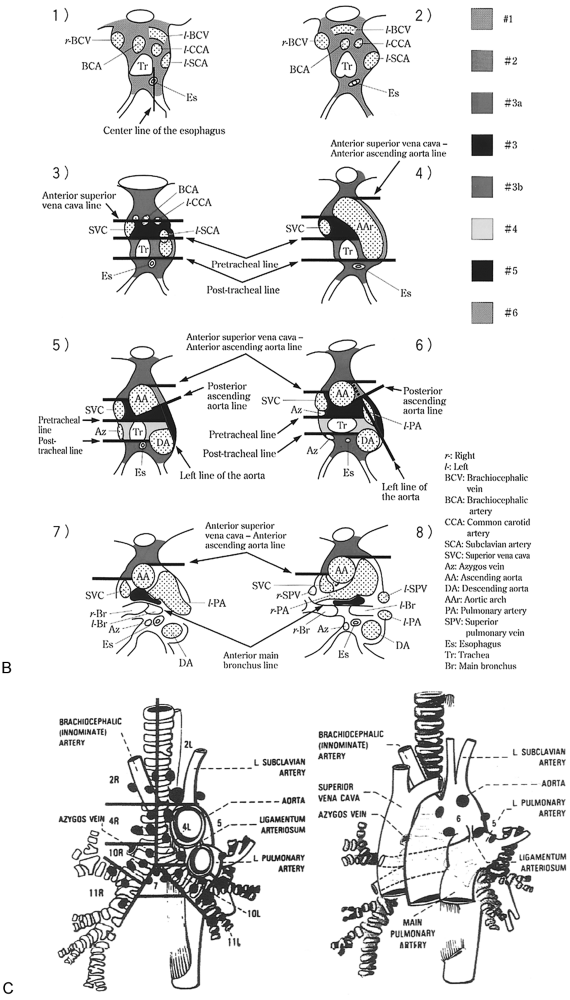 |
Fig. 107-1. B. Sites of mediastinal lymph nodes on computed tomographic scan and cross section. (See Color Fig. 107-1B.) C. Classification for staging of mediastinal lymph nodes recommended by the Lung Cancer Study Group of North America. |
Some classifications have been published with modifications, such as those by the American Thoracic Society (1983) in relation to major anatomic structures and mediastinoscopic identification (Fig. 107-1, C), by Glazer and associates (1985), and, most recently, by Mountain and Dresler (1997) in relation to mediastinal pleura and mediastinoscopic identification. The major differences between the classifications exists in (a) the location of station 10 and (b) station 3, which is included in station 4. In the original map, station 10 represents hilar lymph nodes. In the American Thoracic Society/Lung Cancer Study Group map, station 10 represents mediastinal nodes rather than a hilar lymph node station.
The mediastinal lymph node map I have used in this chapter has been authorized and used by the Committee of the Japan Lung Cancer Society in accordance with the General Rule for Clinical and Pathological Record of Lung Cancer (1987) since 1980 continuously and consistently to the present and has also been recognized for use by the UICC staging committee since 2001.
The sites of mediastinal lymph node stations and their designations as used in this chapter are as follows:
No. 1, the superior mediastinal lymph nodes: located along the upper one-third of the trachea within the thorax. These nodes include those located about the trachea, the location of which is defined by the horizontal line at the level of the upper edge of the subclavian artery and the horizontal line at the center point of the trachea, where the upper edge of the brachiocephalic vein crosses the front of the trachea as the vein ascends to the left.
No. 2, the paratracheal lymph nodes: located between stations 1 and 4 and lateral to the trachea.
No. 3, the pretracheal (No. 3), retrotracheal (No. 3p), and anterior mediastinal (No. 3a): Those located posterior to the trachea are called retrotracheal lymph nodes (No. 3p), and those in the prevascular compartment on the anterior aspect of the brachiocephalic vein and the upper portion of the superior vena cava are called anterior mediastinal lymph nodes (No. 3a).
No. 4, the tracheobronchial lymph nodes: located at or close to the obtuse angle between the trachea and either main-stem bronchus. The nodes on the right side are in the obtuse angle level with and beneath the azygos vein. Those on the left side are located on the medial aspect of the subaortic lymph nodes.
No. 5, the subaortic lymph nodes: located adjacent to the ligamentum arteriosum.
No. 6, the paraaortic lymph nodes: located on the anterolateral wall of the ascending aorta and aortic arch and anterior to the vagus nerve.
No. 7, the subcarinal lymph nodes: located just beneath the point where the trachea is divided into the two main-stem bronchi.
No. 8, the paraesophageal lymph nodes: located caudad to the level of the bifurcation of the trachea and adjacent to the esophagus.
No. 9, the pulmonary ligament lymph nodes: located within the ligament. The lymph nodes that are present on the posterior wall and the lower edge of the inferior pulmonary vein are included in this designation.
No. 10, the nodes just distal to the trachea and extending along the length of the main-stem bronchi. These are also referred to as hilar lymph nodes.
No. 11, the interlobar lymph nodes and those in between the lobar bronchi: On the right side, when these nodes have to be specified, these nodes are classified as lymph nodes existing between the upper and middle lobes (11s) and as nodes existing between the middle and lower lobes (11i).
No. 12, lymph nodes present around a lobar bronchus.
No. 13, lymph nodes located along a segmental bronchus.
No. 14, lymph nodes present around a subsegmental bronchus or distal to this site.
To accurately and correctly analyze the groups of mediastinal lymph nodes on computed tomography (CT) images, the locations and groups have been defined anatomically according to the station numbers and groups of regional lymph nodes. For the boundary of lymph node groups, a straight line should be used in relation to the adjacent structures or organs in the CT slice.
No. 1, superior (highest) lymph nodes in the upper mediastinum: lymph nodes from the apex of the lung to the level of the intersection of the left brachiocephalic vein and midtracheal line (the longitudinal line in the center of the trachea), including the CT slice containing the intersection.
No. 2, paratracheal lymph nodes: lymph nodes caudad to No. 1 and cephalad to the azygos arch; the center of the node is located between the pretracheal line (the horizontal line along the anterior border of the trachea) and the posttracheal line (the horizontal line along the posterior border of the trachea), excluding the CT slice containing the intersection of the left brachiocephalic vein and midtracheal line and of the azygos arch.
No. 3a, anterior mediastinal lymph nodes: lymph nodes caudad to No. 1, with the center of the node located anterior to the line from the superior vena cava (the horizontal line along the anterior border of the superior vena cava) to the anterior wall of the ascending aorta (the horizontal line along the anterior border of the ascending aorta).
No. 3, pretracheal lymph nodes: lymph nodes caudad to No. 1 and cephalad to the right main pulmonary artery, with the center of the node located anterior to the paratracheal line or posterior to the line of the anterior wall of the superior vena cava and to the right of the left margin of the aorta. Lymph nodes located superior to the aortic arch
P.1592
and on the left of the left subclavian artery and left common carotid artery should be classified as No. 6, if these nodes are contiguous to No. 6.No. 3p, retrotracheal lymph nodes: lymph nodes caudad to No. 1, cephalad to the carina, and with the center of the node located posterior to the posttracheal line, excluding the nodes on the CT slice showing bilateral main-stem bronchi.
No. 4, tracheobronchial lymph nodes: lymph nodes caudad to the azygos vein, including the CT slice level showing the azygos vein. The center of the node is located between pretracheal and posttracheal lines. Lymph nodes are located on the right of the left margin line of the aorta and in contact with the trachea on the left of the azygos arch. (The center of the node is located in the region of left No. 4, but the node clearly separate from the trachea should be classified as No. 5.)
No. 5, subaortic lymph nodes: lymph nodes between the aortic arch and the left main pulmonary artery. The center of the node is located on the left of the left margin of the aorta and posterior to the posterior wall of the ascending aorta.
No. 6, paraaortic lymph nodes: lymph nodes located on the left of the ascending aorta and aortic arch. The center of the node is posterior to the anterior wall line of the ascending aorta. In the region where the posterior wall of the ascending aorta is illustrated, lymph nodes are located anterior to the posterior wall line of the ascending aorta.
No. 7, subcarinal lymph nodes: lymph nodes in contact with the subcarina. The center of the node is located posterior to the anterior wall line of the main-stem bronchi (the horizontal line along the anterior border of the main bronchus). (Lymph nodes in contact with the mediastinal side of the bilateral main-stem bronchi or truncus intermedius, and the nodes that are not contiguous to the subcarina, are classified as No. 10.)
No. 8, paraesophageal lymph nodes: lymph nodes caudad to the carina (on the CT slice showing bilateral main-stem bronchi separately), in contact with the esophagus but apart from the bronchi.
No. 9, pulmonary ligament lymph nodes: lymph nodes located caudad to the inferior pulmonary veins.
The following should be noted:
If it is difficult to determine the station number of the mediastinal lymph nodes on CT images, the smaller number should be recorded.
The border of the right and left sides should be determined according to the following line: No. 1, midtracheal line; No. 3a, center line of the anterior mediastinum; and No. 3 and No. 8, center line of the esophagus.
The lymph node group close to the left side of the left main pulmonary artery should be recorded as No. 10(l), which belongs to hilar nodes.
The radicality of lung cancer operation can vary depending on the degree of lymph node dissection. Although the particular location of the primary lesion and the group of lymph nodes that requires dissection depends on the development of cancer, dissection is normally performed through group 2a or group 2b (Table 107-1). In the case of mediastinal
P.1593
lymph node sampling, the following lymph nodes become subject to biopsy: right upper lobe tumor, No. 3 and No. 4; right middle lobe tumor, No. 3 and No. 7; right lower lobe tumor, No. 7; left upper lobe tumor, No. 5 and No. 6; and left lower lobe tumor, No. 7.
Table 107-1. Lymph Node Groups | |||||||||||||||||||||||||||||||||||||||||||||||||||||||||||||||||||||||||||||||||||||||||||||||||||||||||||||||||||||||||||||||||||||||||||||||||||||||||||||||||||||||||||||||||||||||||||||||||||||||||||||||||||||||||||||||||||||||||
|---|---|---|---|---|---|---|---|---|---|---|---|---|---|---|---|---|---|---|---|---|---|---|---|---|---|---|---|---|---|---|---|---|---|---|---|---|---|---|---|---|---|---|---|---|---|---|---|---|---|---|---|---|---|---|---|---|---|---|---|---|---|---|---|---|---|---|---|---|---|---|---|---|---|---|---|---|---|---|---|---|---|---|---|---|---|---|---|---|---|---|---|---|---|---|---|---|---|---|---|---|---|---|---|---|---|---|---|---|---|---|---|---|---|---|---|---|---|---|---|---|---|---|---|---|---|---|---|---|---|---|---|---|---|---|---|---|---|---|---|---|---|---|---|---|---|---|---|---|---|---|---|---|---|---|---|---|---|---|---|---|---|---|---|---|---|---|---|---|---|---|---|---|---|---|---|---|---|---|---|---|---|---|---|---|---|---|---|---|---|---|---|---|---|---|---|---|---|---|---|---|---|---|---|---|---|---|---|---|---|---|---|---|---|---|---|---|---|---|---|---|---|---|---|---|---|---|---|---|---|---|---|---|---|
| |||||||||||||||||||||||||||||||||||||||||||||||||||||||||||||||||||||||||||||||||||||||||||||||||||||||||||||||||||||||||||||||||||||||||||||||||||||||||||||||||||||||||||||||||||||||||||||||||||||||||||||||||||||||||||||||||||||||||
ANESTHESIA
General anesthesia using a double-lumen endobronchial tube is the standard procedure for pulmonary resections with mediastinal lymph node dissection. After the endotracheal tube has been inserted into the trachea, the position of the tube is confirmed by visualization with the bronchofiberscope (3.0-mm diameter Olympus Bf type 3C), and the tube is then fixed in place. Whenever the patient's position is changed, the location of the endotracheal tube must be rechecked for proper positioning.
POSITION OF PATIENT
The patient is placed in the appropriate lateral position, and a posterolateral, anterior axillary, or limited thoracotomy is carried out. The pleural space is entered through the fourth intercostal space. The fourth and fifth ribs are partially dissected for a length of 1.5 to 2.0 cm just proximal to the vertebrae, and a section of each rib is excised. In anterior axillary thoracotomy, partial resection of the anterior cartilaginous portion of the fourth and fifth ribs is performed.
In patients with cancer in the right lung, it is possible to perform a dissection of the potentially involved left contralateral tracheobronchial or paratracheal lymph nodes (or both) combined with a complete dissection of the right ipsilateral mediastinal lymph nodes with the standard right posterolateral thoracotomy. In patients with cancer in the left lung, however, a contralateral lymph node dissection cannot be performed by the standard left thoracotomy for anatomic reasons.
As a standard approach in patients with cancer in the left lung, a left posterolateral thoracotomy may be used if only an ipsilateral mediastinal lymph node dissection is contemplated. A median sternotomy may also be used but has disadvantages, as will be noted. If a bilateral lymph node dissection is indicated, a median sternotomy with a left anterior intercostal incision may be used, or the sternotomy may be combined with a standard left posterolateral thoracotomy.
When a left lung resection is combined with mediastinal lymph node dissection by a median sternotomy only, the disadvantage is that a complete dissection of the subcarinal lymph nodes and of the posterior mediastinal lymph nodes can be difficult to perform. Likewise, a left lower lobectomy is difficult to accomplish readily. Therefore, this incision alone is not recommended.
In patients with cancer in the left lung, frequent metastases are found in the subaortic (No. 5) and the paraaortic (No. 6) lymph nodes. Therefore, the initial procedure to perform for the mediastinal lymph node dissection is a standard left posterolateral thoracotomy with the patient in the right lateral decubitus position. In patients with metastases present in either the tracheobronchial (No. 4) or the subcarinal (No. 7) lymph nodes, or both, however, it is logical to assume the potential presence of metastases in the lymph nodes in the contralateral mediastinum. Because squamous cell carcinomas have a tendency toward localized regional growth only, in some cases the lymphatic route is the major source of spread of disease. Therefore, it is essential to identify possible metastases to the tracheobronchial (No. 4) and the subcarinal (No. 7) lymph nodes by frozen section diagnosis during the operation. When metastases have been identified in these areas, it is then possible to perform a more complete contralateral lymph node dissection in selected cases. In patients with adenocarcinoma of the left lung, bilateral mediastinal resection is believed to be indicated in all cases by most investigators. In patients with left-sided squamous cell tumors metastatic to the left mediastinal nodes, I believe that bilateral dissection is also indicated. In cases where systematic nodal dissection can be performed, the alternative methods include muscle-sparing posterolateral thoracotomy, as suggested by Bethencourt and Holmes (1988); modified muscle-sparing posterolateral thoracotomy, as advocated by Ashour (1990); limited lateral thoracotomy, recommended by Lemmer (1990); anterior limited thoracotomy, reported by Nomori and associates (1999) or lobectomy via video-assisted thoracic surgery (VATS).
MEDIASTINAL LYMPH NODE DISSECTION
Timing
A principle of lung cancer surgery should be the ligation of the pulmonary vein first, followed by en bloc dissection of the mediastinum and hilum together with the lung, without interrupting lymphatic channels during the dissection. Particularly in cases in which nodal enlargement suggests metastases extending from the hilar lymph nodes to mediastinal lymph nodes, the lymphatic channels should not be incised during the dissection. The order of the operative procedure should be changed appropriately during the operation, however, depending on the site and size of the tumor as well as its extent. When the pulmonary lobes in the diseased lung obscure the visual field, the accuracy of dissection is lowered. The basic rule is to vary the standard procedure as necessary, but nonetheless perform a complete dissection even though it may take a longer time to complete the operation than is usually required.
P.1594
Technique
Dissection of the mediastinal lymph nodes is carried out with scissors and electroknife to excise en bloc the fatty tissues of the hilum and mediastinum that contain the lymph nodes while completely exposing all structures and walls of the organs present within the hilum and mediastinum. As noted, the lung, including the fatty alveolar tissues and lymph nodes, is to be dissected en bloc.
Before starting the mediastinal dissection, the pulmonary ligament is separated from the mediastinal pleura adjacent anteriorly and posteriorly to it. The mediastinal pleura inferior to the hilum is then separated from the fatty tissue adjacent to the esophagus. For the dissection of the superior mediastinum, the mediastinal pleura is incised vertically from the upper edge of the hilar pleura just below the azygos vein to the apex of the thorax and opened and retracted away from the mediastinal structures by retraction sutures. The vagus and phrenic nerves are identified, taped, and preserved carefully.
Fatty tissues, including the lymph nodes, held by a lymph node forceps or Allis intestinal forceps, are separated gently to expose the arteries, veins, trachea, bronchi, esophagus, and the aforementioned nerves. At all times, it is necessary to be careful not to damage the lymph nodes but to dissect free the adipose tissue enclosing the lymph nodes. The adipose tissues are grasped by the forceps without grasping the lymph nodes. When lymph nodes are squeezed, cancer cells can spread into the operated field; therefore, the nodes should not be grasped during the procedure. It is necessary to ligate any small blood vessels and to cauterize small lymphatic channels by electroknife to prevent postoperative bleeding and exudation of lymphatic fluid into the hemithorax postoperatively.
Patients with Carcinoma of the Right Lung
Right Upper Lobectomy
When a right upper lobectomy is performed, the operator initially stands at the back of the patient and moves to the front after the thoracotomy incision has been completed. The hilar pleura is opened anteriorly just posterior to the phrenic nerve, and the phrenic nerve is then isolated, taped, and retracted to prevent any injury to it. Next, the fatty tissues and contained lymph nodes are dissected off the pericardium from the site of the pleural incision toward the hilum to expose the superior pulmonary vein. The superior pulmonary vein, except for its branch from the middle lobe, is isolated, ligated, and divided. Following this maneuver, the azygos vein can be divided, or this step can be done after the upper mediastinal dissection has been completed, depending on feasibility at the respective times.
The tracheobronchial lymph nodes (No. 4) are present on the medial side and the undersurface of the azygos vein; when the cancer is located in the right upper lobe, these No. 4 nodes as well as the pretracheal lymph nodes (No. 3) are frequently involved by metastatic disease. When it is suspected by the gross appearance of these nodes that they are involved, the azygos vein is not divided at its middle but is divided proximally as it enters the superior vena cava and distally as it turns anteriorly from its location on the vertebral bodies. That portion of the azygos vein overlying the tracheobronchial lymph nodes (No. 4) is thus left attached to this nodal group, and a combined excision of the azygos vein and tracheobronchial lymph nodes is performed in selected cases.
The lung is next retracted anteriorly to expose the posterior aspect of the hilum, and the pleura is incised posterior to the hilar structures. The vagus nerve is exposed and taped. The pulmonary branch or branches of the vagus nerve are divided. Next, an intestinal flexible ribbon retractor is placed beneath the bifurcation of the trachea and the area is exposed, taking care to avoid injury to the descending aorta. The contralateral left main-stem bronchial lymph nodes (No. 10, left) are brought to the midline by the use of a lymph node forceps, and dissection of the subcarinal lymph nodes (No. 7) is started. A branch of the bronchial artery, which runs from the tracheal bifurcation to the posterior wall of the right main bronchus, is ligated and divided.
P.1595
The medial side of the left main-stem bronchus is exposed as it ascends toward the tracheal bifurcation. Along with the contralateral left main-stem bronchial lymph nodes (No. 10, left), the subcarinal lymph nodes (No. 7), the right main-stem bronchial lymph nodes (No. 10, right), and the right upper lobe bronchial lymph nodes (No. 12) are dissected en bloc from the surrounding structures. It is readily seen during the dissection that these lymph nodes are in direct continuity with each other (see Figs. 107-2 and 107-3).
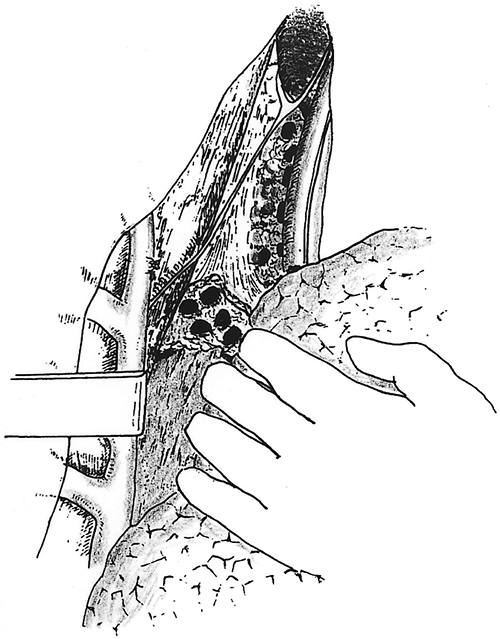 |
Fig. 107-2. Exposure of the subcarinal area during a right upper lobectomy by retraction of lung toward the operator at the front of the patient. |
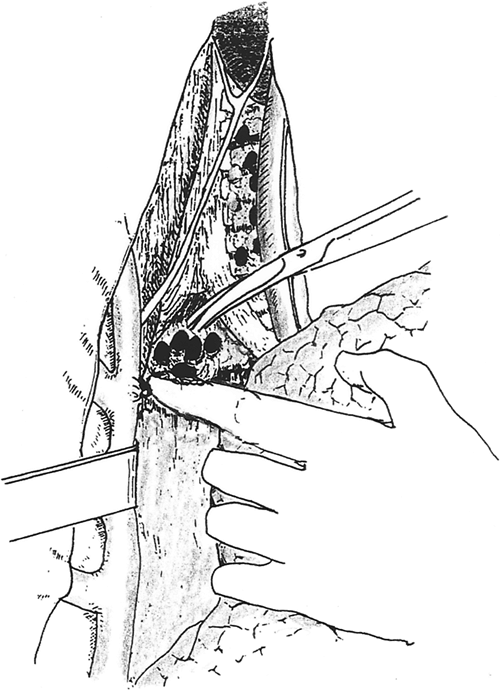 |
Fig. 107-3. Sharp scissors dissection of the subcarinal fat pad containing the subcarinal (No. 7) lymph nodes. |
The next step is separation of the interlobar fissure, and then the posterior ascending artery is isolated, ligated, and divided. The lymph nodes present between the lobes are dissected free from the pulmonary artery in continuity with the upper lobe. The lymphatic sump area located in the area between the upper lobe bronchus, middle lobe bronchus, and the superior segmental branch of the lower lobe bronchus contains regional lymph nodes (No. 11s) that receive lymphatic drainage from the upper lobe. It is necessary to dissect and to remove these nodes as completely as possible together with the peribronchial lymph nodes (No. 12) of the upper lobe bronchus.
When it is suspected that the dissection of superior interlobar lymph nodes (No. 11s) might be incomplete when only a right lobectomy is carried out in some cases of a right upper lobe tumor, a more complete dissection of these nodes as well as of the peribronchial lymph nodes (No. 12) may be accomplished by a right upper and middle bilobectomy. Furthermore, if the sump area contains large, involved lymph nodes and the bronchus or pulmonary artery, or both, have been infiltrated by metastatic disease from the involved lymph nodes or by the tumor itself, a pneumonectomy is indicated.
When the dissection of the subcarinal, hilar, and peribronchial lymph nodes is completed, the surgeon should move to the opposite (back) side of the patient. When the azygos vein has not been divided previously, it is now exposed and ligated. The vein is then transfixed and divided. As noted previously, a part of the azygos vein may be left attached to underlying tracheobronchial lymph nodes (No. 4) and removed together with the lymph nodes at the completion of the dissection.
The mediastinal pleura is then opened from the upper edge of the hilar pleura upward toward the apex of the thorax. Sutures are placed through either edge of the opened upper mediastinal pleura at four points, and the pleural incision is held open by traction on these sutures to expose the superior aspect of the mediastinum above the hilum.
The pleura is incised further cephalad to the level of the upper edge of the subclavian artery. The right recurrent nerve is identified and protected from injury. The wall of the subclavian artery is exposed, and the superior mediastinal lymph nodes (No. 1) and the adjacent fatty tissue are dissected free from the mediastinal structures. The right brachiocephalic vein is retracted anteriorly with an intestinal flexible ribbon retractor. The adipose tissues located at the highest level of the anterior and the right lateral surfaces of the trachea are grasped with lymph node forceps or Allis intestinal forceps and retracted toward the operator, and sharp dissection is performed to free this tissue and any contained lymph nodes from this portion of the trachea (Figs. 107-4 and 107-5). To prevent postoperative lymphatic leaks or bleeding, ligation or electrocauterization of all cut vascular or lymphatic vessels is done as completely as possible. The right vagus nerve is exposed starting at the level of the takeoff of the recurrent nerve. Then, the right lateral wall of the esophagus and right lateral wall of the trachea are exposed. The adipose tissue, including the contained lymph nodes existing at the highest site (No.1), is held by lymph node forceps and the dissection is continued downward toward the hilum. A few thin venous branches from the right brachiocephalic vein and superior vena cava are usually present; these branches are ligated and divided. The intestinal flexible ribbon retractor is slid downward a little and inserted between the trachea and the right brachiocephalic vein near its junction with the superior vena cava. At the bottom of this site, the ascending brachiocephalic artery is identified. Because the right wall of the ascending aorta is further caudal, the dissection is carried down along the aforementioned arterial branch until the wall of the aorta is exposed.
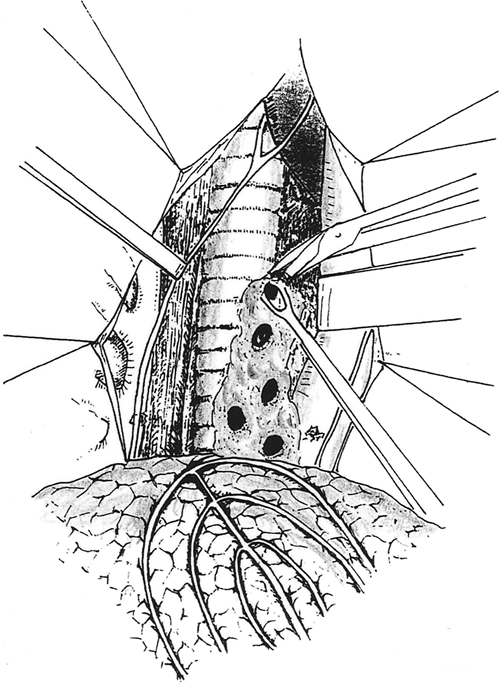 |
Fig. 107-5. Continued downward dissection along the anterolateral wall of the trachea, with the retraction of the superior vena cava anteriorly to free the paratracheal (No. 2) lymph nodes. |
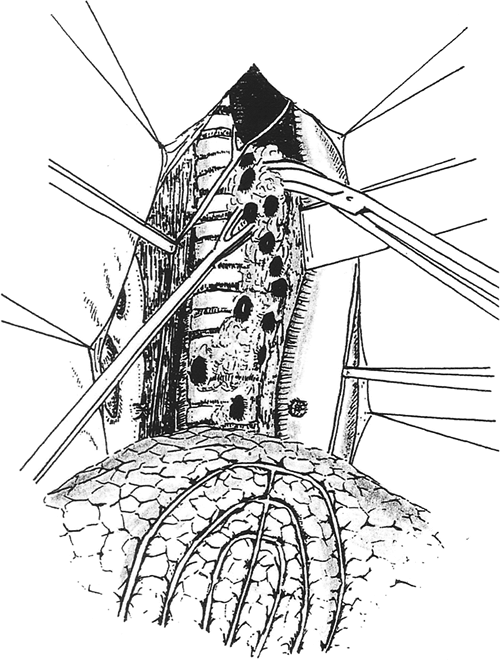 |
Fig. 107-4. Beginning dissection of the superior mediastinal lymph nodes at the level of the right subclavian artery. |
P.1596
The pretracheal lymph nodes (No. 3), which, as noted, are located where the upper edge of the left brachiocephalic vein crosses the anterior aspect of the trachea, are then dissected in continuity with the tissues already freed from above. The lymph nodes at this site are numerous and metastasis to these nodes in patients with cancer in the right upper lobe occurs frequently; only the tracheobronchial lymph nodes (No. 4) and the paratracheal lymph nodes (No. 2) are more prone to metastatic involvement.
The retrotracheal (No. 3p) lymph nodes are then freed, and the paratracheal (No. 2) nodes along with previously dissected fatty tissue and lymph nodes from above are dissected away from the tracheal wall and the posterior wall of the lower portion of the superior vena cava. The dissection is continued down to and including the superior tracheobronchial (No. 4) lymph nodes and attached section of the azygos vein when these latter lymph nodes are enlarged, thus completing the superior mediastinal lymph node dissection.
Next, the right pulmonary artery is exposed, and the upper lobectomy combined with dissection of the mediastinal lymph nodes is completed by the following procedure. The right upper lobe artery (the truncus anterior) is isolated, ligated, and divided. The lymph nodes attached to the anterior aspect of the upper lobe bronchus are dissected in continuity with the tracheobronchial lymph nodes (No. 4), which have been freed previously (Fig. 107-6). The dissection is completed with isolation, division, and closure of the right upper lobe bronchus. In patients with cancer in the upper lobe, it is not necessary to perform a dissection of the paraesophageal (No. 8) lymph nodes, but the pulmonary ligament lymph nodes (No. 9) are removed with the specimen.
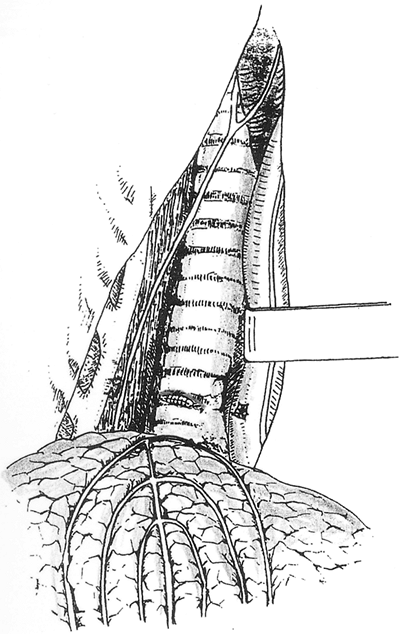 |
Fig. 107-6. Status of the superior mediastinal area after complete dissection and removal of the right upper lobe. Proximal and distal ligated ends of the azygos vein are clearly seen. |
Middle Lobectomy
In patients with a cancer in the middle lobe, a bilobectomy of the middle and upper lobes or of the middle and lower lobes is performed, depending on the extent of metastasis to the interlobar lymph nodes (No. 11s or No. 11i). Pneumonectomy is carried out as necessitated by the extent of the spread of metastasis to the lymph nodes or the direct extent of the primary tumor. The mediastinal lymph node dissection is essentially the same as that carried out for upper lobe tumors.
P.1597
Right Lower Lobectomy
For excision of the right lower lobe, the surgeon stands at the back of the patient. After opening the right side of the chest and freeing any adhesions as necessary, the mediastinal pleura is incised just anterior to the pulmonary ligament, as well as posterior to it. The esophagus is exposed from the diaphragm up to the inferior pulmonary vein. Dissection continues in a superior direction, and the pulmonary ligament and paraesophageal (No. 9 and No. 8) lymph nodes are dissected en bloc with the adjacent fatty tissue up to the inferior pulmonary vein. The pleura behind the vein is incised, and the inferior pulmonary vein is exposed, ligated, and divided.
The surgeon now moves to the front of the patient, and the esophagus is retracted posteriorly by an intestinal flexible ribbon retractor placed at the level of the bifurcation of the trachea. The lung is retracted anteriorly toward the surgeon's side, and the bifurcation of the trachea is exposed. Dissection of lymph nodes at the bifurcation of the trachea (No. 7) is performed first, and then the nodes present along the right main-stem bronchus (No. 10, right) are dissected down to the lower lobe. Next, the major interlobar fissure is opened using an electroknife to expose the bronchovascular structures. The interlobar lymph nodes (No. 11s and No. 11i) and the lymph nodes clustered around the lower lobe bronchus are dissected free along with the previously dissected lymph nodes at the bifurcation of the trachea and the peribronchial lymph nodes of the right main bronchus. The pulmonary artery branch or branches to the lower lobe are isolated, ligated, and divided. Next, the lower lobe bronchus is divided and the proximal stump is closed. Then, the lymph node dissection of the upper mediastinum is performed as previously described.
Right Pneumonectomy
The technical steps of a right pneumonectomy are taken in the following order: dissection of the inferior mediastinum, ligation and division of the inferior and superior pulmonary veins, dissection of the bifurcation of the trachea, dissection of the upper mediastinum, ligation and division of the pulmonary artery, and finally division and closure of the right main-stem bronchus. The area of dissection of the lymph nodes present in the hilum and mediastinum when a right pneumonectomy is performed is shown in Figure 107-7.
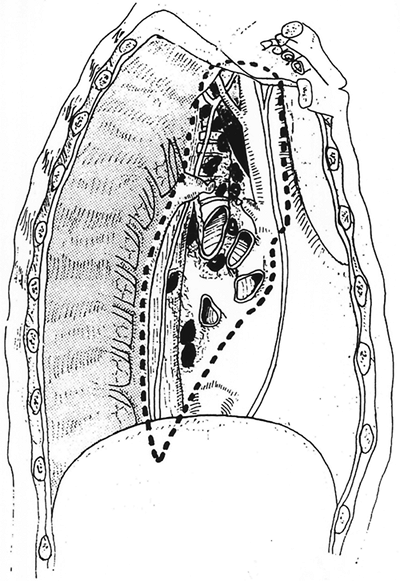 |
Fig. 107-7. View of the right side of the mediastinum. The outline denotes the region of dissection of the right hilum and mediastinum with contained hilar and mediastinal structures exposed during right pneumonectomy. |
P.1598
Patients with Carcinoma of the Left Lung
Left Upper Lobectomy
For a left upper lobectomy, the surgeon moves to the front side of the patient after performing the thoracotomy incision into the pleural space. The mediastinal pleura is incised anterior to the hilum. The phrenic nerve is identified and taped. Lymph nodes in the region of the pulmonary vein are dissected from the anterior aspect of the pericardium toward the pulmonary side of the superior pulmonary vein. The superior pulmonary vein is isolated, ligated, and divided.
The lung is retracted anteriorly toward the surgeon, and dissection of subcarinal lymph nodes (No. 7) is started. First, the vagus nerve is isolated and taped. The descending aorta and esophagus are retracted posteriorly by an intestinal flexible ribbon retractor, and the bifurcation of the trachea is exposed (Fig. 107-8). The bronchus is exposed from the inferior border of the upper lobar bronchus toward the main bronchus. Lymph nodes about the left upper lobar bronchus are mobilized, and the dissection is continued distally on the bronchus to the area of the bifurcation of the bronchus between the upper and lower lobes (the left lymphatic sump). The pulmonary branches of the vagus nerve are ligated and divided. With completion of these steps, the visual field of the tracheal bifurcation is increased by further retraction of the left lung toward the surgeon by use of the left hand or a lung retractor. Lymph nodes are dissected away from the inferior surface of the right main bronchus (No. 10, right); then, the subcarinal lymph nodes (No. 7) are dissected free; and finally, the left bronchial hilar lymph nodes (No. 10, left) are mobilized. It is necessary at the site of the bifurcation of the trachea to ligate and divide the branch of the left bronchial artery. The dissection of the sump lymph nodes between the upper lobe and lower lobe bronchus is completed after division of the interlobar fissure and separation of the lobes. The branches of the pulmonary artery are ligated and divided from below upward, but all of the arterial branches may not be divided at this stage.
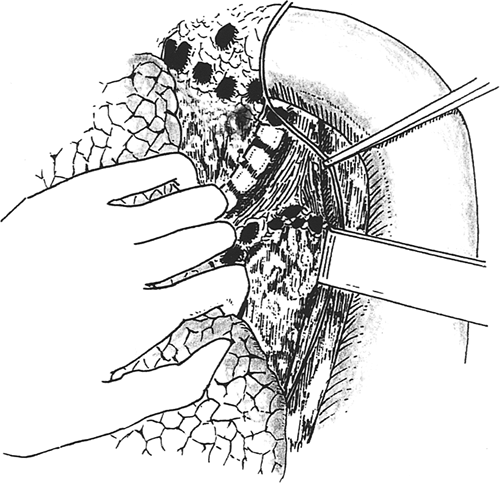 |
Fig. 107-8. Exposure of the subcarinal area from the left side after division of the inferior pulmonary vein. Retraction of the left lung anteriorly and the esophagus posteriorly permits the operative exposure of the carina and both the right and left main-stem bronchi. |
Next, the upper mediastinal pleura is incised as far as the apex of the thorax, and the phrenic and vagus nerves are identified and taped. Four retraction sutures are placed in the cut edges of the mediastinal pleura. The hemiazygos vein is identified, isolated, ligated, and divided. Anteriorly, the thymic fatty tissue is identified and the pericardium is reached when this adipose tissue is dissected free. The ascending aorta is exposed, and the paraaortic (No. 6) lymph nodes are dissected from the aortic wall. The dissection is carried toward the main pulmonary artery in the hilum. The left brachiocephalic vein is also exposed. Now, a portion of the anterior mediastinal fat pad containing the anterior mediastinal (No. 3a) lymph nodes can be dissected.
The left common carotid and the left subclavian arteries are exposed at the apex of the thorax, and caudad dissection of the fatty tissue containing the lymph nodes is carried out. The superior mediastinal (No. 1) and paratracheal (No. 2) lymph nodes are dissected as shown in Fig. 107-9. The left superior mediastinal lymph nodes (No. 1), as on the right, are the nodes present at the apex to the level where the upper edge of the brachiocephalic vein crosses the midline of the trachea; the lymph nodes present below this level on the side of the trachea are the paratracheal lymph nodes (No. 2). The lymph nodes located on the frontal aspect of the left common carotid artery are pretracheal (No. 3) and are also dissected at this time.
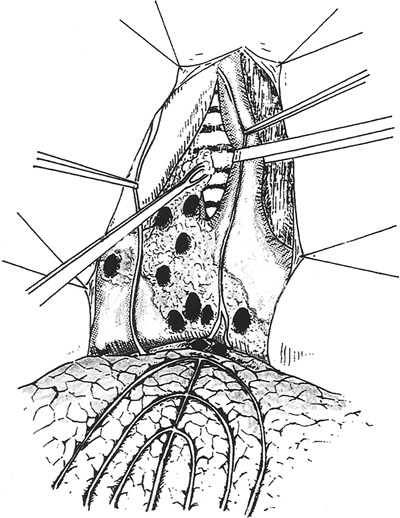 |
Fig. 107-9. Exposure of the left superior mediastinal and paratracheal lymph nodes during a standard left thoracotomy by retraction of the left common carotid artery posteriorly and the left brachiocephalic vein anteriorly. |
The thoracic duct is in the deepest area between the left common carotid artery and the left subclavian artery; however, the thoracic duct, as a rule, cannot be identified. Damage to mediastinal branches of the thoracic duct can result in a postoperative chylothorax. Therefore, all lymphatic channels and fine blood vessels should be ligated and divided. When the left subclavian artery is taped, paratracheal lymph nodes (No. 2) can be dissected more easily. Lymph nodes in the deeper area between the left brachiocephalic vein and left common carotid artery are pretracheal lymph nodes (No. 3). It is impossible to dissect all the nodes on the anterior surface of the trachea with the standard operative procedure of a left thoracotomy; therefore, when dissection in this area is necessary, the aorta should be mobilized and retracted or the dissection of the superior mediastinum should be performed through a median sternotomy. After dissection of the paratracheal and pretracheal nodes, attention is turned to the dissection of the remaining paraaortic and subaortic nodes.
P.1599
In patients with cancer in the left upper lobe, it is most important to dissect the paraaortic lymph nodes (No. 6) as well as the subaortic lymph nodes (No. 5). The tracheobronchial lymph nodes (No. 4) are located at the median side of the subaortic lymph nodes, and these nodes can be dissected easily after Botallo's ligament has been ligated and divided.
The remaining (ordinarily the more proximal) pulmonary arteries of the upper lobe are now isolated, ligated, and divided. After exposing the left upper lobe bronchus together with the dissected nodes, the bronchus is divided. By this procedure, left upper lobectomy combined with mediastinal lymph node dissection is completed.
When metastases are identified in the subcarinal lymph nodes (No. 7) or the tracheobronchial lymph nodes (No. 4), or both, it is necessary to perform a complete dissection of the superior mediastinal (No. 1), paratracheal (No. 2), pretracheal (No. 3), and posterior mediastinal (No. 3p) lymph nodes. This may be accomplished by one of two procedures. The steps of one of the procedures are to tape the subclavian artery, incise the pleura at the posterior side of the aorta, ligate and divide a few intercostal arteries, and tape the descending aorta. The left subclavian artery and aorta are retracted anteriorly and the left wall of the trachea and esophagus are exposed. The superior mediastinal (No. 1), paratracheal (No. 2), pretracheal (No. 3), and retrotracheal (No. 3p) lymph nodes are more readily dissected with this maneuver (Fig. 107-10). At this time, it is necessary to pay careful attention to avoid damaging the recurrent nerve, which runs upward along the left lateral wall of the trachea. By incision of Botallo's ligament, the tracheobronchial (No. 4) lymph nodes can be dissected easily as previously described. The other option is to move the patient to a supine position and to perform a median sternotomy to carry out a more complete mediastinal lymph node dissection. This operative approach is described subsequently.
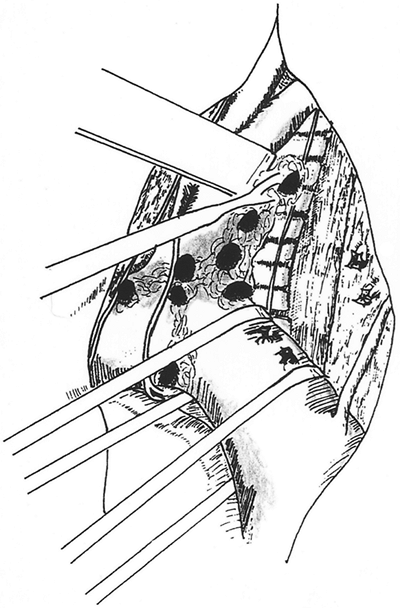 |
Fig. 107-10. Upper intercostal arteries have been divided and the aorta and the left subclavian and common carotid arteries have been retracted anteriorly to give more complete access to the superior mediastinal (No. 1), the left paratracheal (No. 2), the pretracheal (No. 3), and the retrotracheal (No. 3p) lymph nodes during a standard left thoracotomy incision. |
Left Lower Lobectomy
When a left lower lobectomy is performed in patients with the primary lesion in the left lower lobe, the surgeon moves to the front of the patient. The pulmonary ligament lymph nodes (No. 9) are freed, and the paraesophageal (No. 8)
P.1600
lymph nodes are dissected from about the esophagus from the anterior surface of the descending aorta posteriorly to the pericardial surface anteriorly. These nodes are dissected upward and the inferior pulmonary vein is exposed. The inferior pulmonary vein is then isolated, ligated, and divided. The lung is further retracted anteriorly toward the surgeon, and dissection of the contralateral hilar lymph nodes (No. 10, right), the subcarinal lymph nodes (No. 7), and the ipsilateral hilar lymph nodes (No. 10, left) is performed. After opening the interlobar fissure, the dissection of the interlobar lymph nodes (No. 11) is accomplished. The lower lobectomy is completed with ligation and division of the pulmonary arterial branches to the lobe and division and closure of the bronchus. In patients with cancer in the left lower lobe, as well as in those patients with metastases to subaortic lymph nodes (No. 5), the subcarinal lymph nodes (No. 7) are frequently involved and must be included in the dissection.
Left Pneumonectomy
When a left pneumonectomy is indicated, the operative steps for dissection of mediastinal lymph nodes are started by the surgeon moving to the front side of the patient after the pleural space is entered. The area of dissection of the hilar and the mediastinal lymph nodes during a left pneumonectomy is shown in Figure 107-11. The pulmonary ligament lymph nodes (No. 9) and the paraesophageal (No. 8) lymph nodes are dissected, as for a lower lobectomy, and the dissection is continued superiorly as far as the inferior pulmonary vein. This vein is ligated and divided. Next, the superior pulmonary vein is ligated and divided. The mediastinal dissection is then continued as described for a left upper lobectomy. As noted previously, the area of the left upper mediastinum is narrow and its borders are not defined as clearly as are the borders of the right upper mediastinum. The superior mediastinal (No. 1), pretracheal (No. 3), and paratracheal (No. 2) lymph nodes are covered by the aorta and its branches. Therefore, it is not possible to perform a complete dissection of these nodes unless the brachiocephalic vein, aorta, and carotid arteries are retracted.
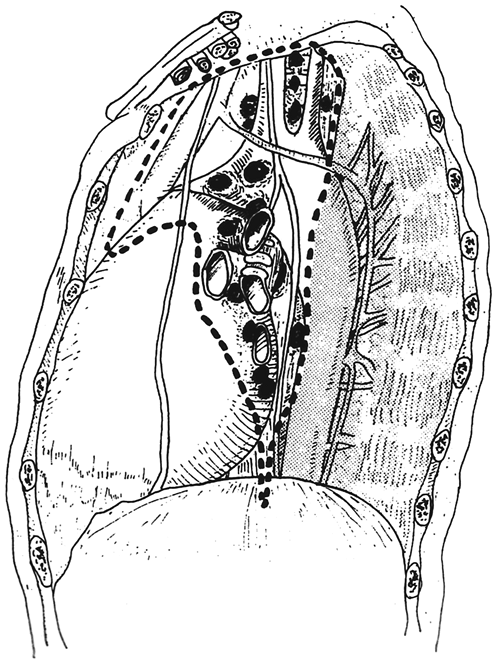 |
Fig. 107-11. The mediastinum as viewed during a standard left thoracotomy. The outline denotes the region of hilar and mediastinal dissection with contained exposed hilar and mediastinal structures during a left pneumonectomy. |
With the nodal dissection completed, the main pulmonary artery is exposed, ligated, and divided. By dividing the left main bronchus, the left pneumonectomy has been accomplished with dissection of the mediastinal lymph nodes en bloc. Of course, the mediastinal lymph node dissection can be performed after the pulmonary resection has been performed. As a rule, however, the lung can usually be collapsed easily, and therefore the operation is not difficult with the lung in place and is recommended as the procedure of choice.
Upper Mediastinal Dissection Via a Median Sternotomy
In patients with cancer of the left lung and metastases in the subcarinal lymph nodes (No. 7) or in the tracheobronchial lymph nodes (No. 4), particularly those persons with squamous cell carcinoma, a more complete dissection of the mediastinum is indicated. This may be performed by accomplishing the dissection via a median sternotomy. In a case of cancer invading from the left main bronchus into the carina, for which carinal resection should be done, a mediastinal lymph node dissection should be performed via a median sternotomy. The patient is placed supine and a median sternotomy is carried out to improve the dissection of the upper mediastinal lymph nodes. The left brachiocephalic vein is exposed and taped. The right brachiocephalic artery and common carotid artery are taped. Care is needed to avoid damaging the recurrent nerve that is present at the left side of the trachea.
Dissection is started precisely underneath the thyroid gland, and the superior mediastinal lymph nodes (No. 1), the paratracheal lymph nodes (No. 2) bilaterally, and any pretracheal lymph nodes (No. 3) are dissected en bloc (Fig. 107-12). To expose lymph nodes in the inferior portion of the trachea, the pericardium between the superior vena cava and ascending aorta is incised. The aorta is retracted out of the way by using an intestinal flexible ribbon retractor, and the posterior wall of the pericardium is incised medial to
P.1601
the superior vena cava and as far inferiorly as the lower edge of the pulmonary artery. The superior vena cava is retracted to the right side and the brachiocephalic artery is retracted upward. The superior mediastinal lymph nodes (No. 1), which already have been dissected, the left and right paratracheal lymph nodes (No. 2), and the pretracheal lymph nodes (No. 3) are dissected downward, going underneath the brachiocephalic artery. The dissection is then carried downward to the level of the tracheal bifurcation by retraction of the superior vena cava to the right and the ascending aorta to the left (Figs. 107-13 and 107-14). The superior tracheobronchial (No. 4) lymph nodes on the right, as well as any tissue on the left that remains despite the previous dissection of the area during the initial standard left thoracotomy, are removed. During the left-sided dissection, care is needed to protect the left recurrent nerve. The subcarinal (No. 7) area is further inspected, although this area should be clear as a result of the dissection accomplished during the left thoracotomy.
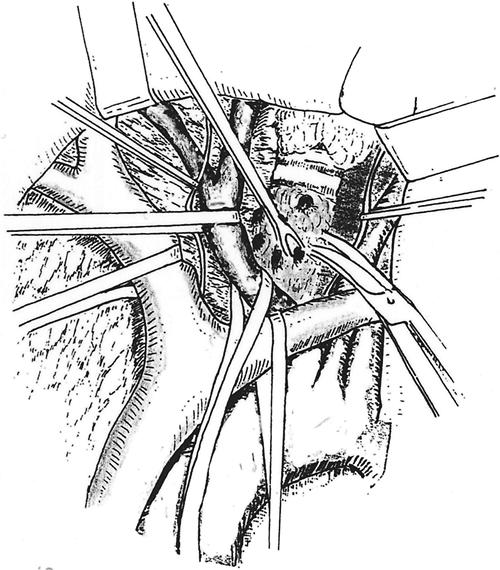 |
Fig. 107-12. Upper mediastinal lymph node dissection through a median sternotomy. The superior portion of the trachea is exposed by downward retraction of the innominate artery and left brachiocephalic vein. |
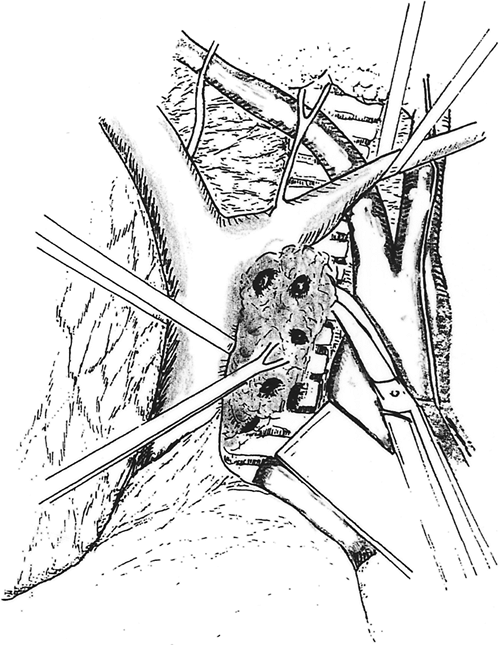 |
Fig. 107-13. Dissection of the pretracheal (No. 3) and paratracheal (No. 2) lymph nodes through a median sternotomy. The superior vena cava is retracted to the right and the aorta to the left after division of the upper anterior and posterior layers of the pericardial sac. |
 |
Fig. 107-14. Continued dissection of pretracheal (No. 3) and subcarinal (No. 7) lymph nodes through the median sternotomy incision described in Fig. 107-13. |
Lymph Node Sampling
Oncologic systematic nodal dissection in a radical operation for lung cancer serves to bring local control of lung cancer. Lobectomy or pneumonectomy combined with complete oncologic nodal dissection is the standard procedure. Lymph node sampling only requires dissection, in a minimally invasive way, of those lymph nodes with a possibility of metastasis, but not those without metastasis.
A study was done to determine sentinel lymph nodes while seeking to practice systematic nodal dissection rationally with regard to each location invaded by lung cancer. Lymph nodes with signs of histologic metastasis among the 1,815 cases of non small cell lung cancer (NSCLC) that underwent complete nodal dissection were recorded by each lymph node station as in the original map by me and my colleagues (1999). In addition, a study of sentinel node identification by use of technetium Tc 99 tin colloid was reported by Nomori and associates (2002). These studies indicate the probability of sites of lymph node metastasis by each lobe invaded by cancer.
The sentinel lymph node is uniformly identified as a mediastinal lymph node, but with differing numerical stations. That is to say, in right upper lobe tumor, it is No. 3 and No. 4; right middle lobe tumor, No. 3 and No. 7; right lower lobe tumor, No. 7; left upper lobe tumor, No. 5 and No. 6; and left lower lobe tumor, No. 7. When metastasis is found in any of these nodes, it should be seen as a sign indicating
P.1602
possibilities of other metastases, and therefore, certain measures should be considered. However, a T1 lung cancer of less than 3 cm tumor size is a different problem; when the sentinel lymph node sampling indicates no sign of metastasis, the chance of N2 level metastasis is only 5.9%. Moreover, in both right and left upper lobe tumors, No. 7 lymph node metastasis should not be present, given that in our studies, sentinel node sampling for these upper lobe tumors proved no metastasis in these sites.
Understanding the anatomic and pathologic characteristics of the lymphatic spread in each lobe and sentinel lymph node is not only useful in staging patients with lung cancer through a minimally invasive approach but also effective in the resection of early-stage lung cancer as well as the treatment of compromised patients.
REFERENCES
American Thoracic Society: Clinical staging of primary lung cancer. Am Rev Respir Dis 127:659, 1983.
Ashour M: Modified muscle sparing posterolateral thoracotomy. Thorax 45:935, 1990.
Bethencourt DM, Holmes EC: Muscle-sparing posterolateral thoracotomy. Ann Thorac Surg 45:337, 1988.
Borrie J: Primary carcinoma of the bronchus: prognosis following surgical resection. Ann R Coll Surg Engl 10:165, 1952.
Cahan WG: Radical lobectomy. J Thorac Cardiovasc Surg 39:555, 1960.
Glazer GM, et al: Normal mediastinal lymph nodes: number and size according to American Thoracic Society mapping. AJR Am J Roentgenol 144:261, 1985.
Izbicki JR, et al: Radical systematic mediastinal lymphadenectomy in non-small cell lung cancer: a randomized controlled trial. Br J Surg 81:229, 1994.
The Japan Lung Cancer Society: General Rule for Clinical and Pathological Record of Lung Cancer. 3rd Ed. Tokyo: Kanehara Syuppann, 1987, p. 69.
Keller SM, et al: Mediastinal lymph node dissection improves survival in patients with stages II and IIIa non-small cell lung cancer. Eastern Cooperative Oncology Group. Ann Thorac Surg 70:358, 2000.
Kirschner PA: Lung cancer. Preoperative radiation therapy and surgery. NY State J Med 81:339, 1981.
Kirsh MM, Sloan H: Mediastinal metastases in bronchogenic carcinoma: influence of postoperative irradiation, cell type, and location. Ann Thorac Surg 33:459, 1982.
Lemmer JH Jr, et al: Limited lateral thoracotomy. Improved postoperative pulmonary function. Arch Surg 125:873, 1990.
Martini N: Improved methods of recording data in lung cancer. Clin Bull 6:93, 1976.
Martini N, et al: Results of resection in non-oat cell carcinoma of the lung with mediastinal lymph node metastases. Ann Surg 198:386, 1983.
Mountain CF: Cancer of the lung. In American Joint Committee on Cancer Staging and End Results: Classification and Staging of Cancer by Site. Chicago: American Joint Committee on Cancer Staging and End Results, 1976, p. 95.
Mountain CF, Dresler CM: Regional lymph node classification for lung cancer staging. Chest 111:1718, 1997.
Naruke T: The spread of lung cancer and its relevance to surgery. J Jpn Surg Soc 68:1607, 1967.
Naruke T, Suemasu, Ishikawa S: Surgical treatment for lung cancer with metastasis to mediastinal lymph nodes. J Thorac Cardiovasc Surg 71:2, 1976.
Naruke T, et al: Lymph node mapping and curability at various levels of metastasis in resected lung cancer. J Thorac Cardiovasc Surg 76:832, 1978.
Naruke T, et al: Lymph node sampling in lung cancer: how should it be done? Eur J Cardiothorac Surg 16(suppl 1):S17, 1999.
Nohl HC: An investigation into the lymphatic and vascular spread of carcinoma of the bronchus. Thorax 11:172, 1956.
Nohl HC: The Spread of Carcinoma of the Bronchus. London: Lloid-Luke, 1962.
Nomori H, Horio H, Suemasu K: Intrathoracic light assisted anterior thoracotomy in lung cancer surgery. Surg Today 29:606, 1999.
Nomori H, et al: Use of technetium-99m tin colloid for sentinel lymph node identification in non-small cell lung cancer. J Thorac Cardiovasc Surg 124:486, 2002.
Rouviere H: Anatomie der Lymphatiques de l'Homme. Paris: Masson et Cie, 1932.
Rubinstein I, et al: Resectional surgery in the treatment of primary carcinoma of the lung with mediastinal lymph node metastases. Thorax 34:33, 1979.
Smith RA: The importance of mediastinal lymph node invasion by pulmonary carcinoma in selection of patients for resection. Ann Thorac Surg 25:5, 1978.
Watanabe Y, et al: Aggressive surgical intervention in N2 non-small cell cancer of the lung. Ann Thorac Surg 51:253, 1991.
SUGGESTED READING
American Joint Committee on Cancer: Lung. In Beahrs OH, et al. (eds): Manual for Staging of Cancer. 4th Ed. Philadelphia: J.B. Lippincott, 1992, pp. 115 121.
British Thoracic Society and Society of Cardiothoracic Surgeons of Great Britain and Ireland Working Party: Guidelines on the selection of patients with lung cancer for surgery. Thorax 56:89, 2001.
Cahan WG, Watson WL, Pool JL: Radical pneumonectomy. J Thorac Cardiovasc Surg 22:449, 1951.
Carr DT: Staging of Lung Cancer. Chicago: American Joint Committee for Cancer Staging and End-Results Reporting, 1979.
P.1603
Goldstraw P: Report on the International Workshop on Intrathoracic Staging. Lung Cancer 18:107,1997.
Hata E, et al: Rationale for extended lymphadenectomy for lung cancer. Theor Surg 5:19, 1990.
Hata E, et al: Superradical operation for lung cancer: bilateral mediastinal dissection (BMD) with or without cervical dissection (CD). Lung Cancer Suppl 2:41, 1994.
Hata E, et al: The efficiency of systematic mediastinal dissection for survival and investigation into lymph node metastasis in patients of non-small cell lung cancer. Lung Cancer 18(suppl 1): 373, 1997.
International Union Against Cancer. TNM Classification of Malignant Tumors. 6th Ed. Wiley-Liss, 2002.
Izbicki JR, et al: Effectiveness of radical systematic mediastinal lymphadenectomy in patients with resectable non-small cell lung cancer: results of a prospective randomized trial. Ann Surg 227:138, 1998.
The Japan Lung Cancer Society: Classification of Lung Cancer. 1st English Ed. Tokyo: Kanehara, 2000.
Miller DL, et al: Results of surgical resection in patients with N2 non-small cell lung cancer. Ann Thorac Surg 57:1095, 1994.
Naruke T: Significance of lymph node metastases in lung cancer. Semin Thorac Cardiovasc Surg 5:210, 1993.
Naruke T, et al: Prognosis and survival after resection for bronchogenic carcinoma based on the 1997 TNM-staging classification: the Japanese experience. Ann Thorac Surg 71:1759, 2001.
Pearson FG, et al: Significance of positive superior mediastinal nodes identified at mediastinoscopy in patients with resectable cancer of the lung. J Thorac Cardiovasc Surg 83:1, 1982.
Riquet M, et al: Factors determining survival in resected N2 lung cancer. Eur J Cardiothorac Surg 9:300, 1995.
Union Internationale Contre le Cancer: Illustrated Guide to the TNM/ pTNM-Classification of Malignant Tumors. 3rd Ed. Geneva: Union Internationale Contre le Cancer, 1989.
Watanabe Y, et al: Mediastinal nodal involvement and the prognosis of non-small cell lung cancer. Chest 100:422, 1991.
EAN: 2147483647
Pages: 203